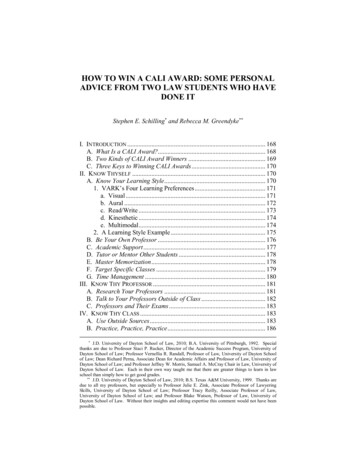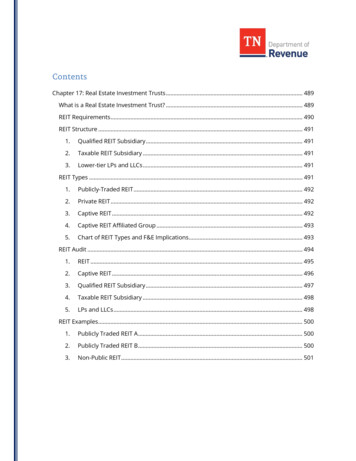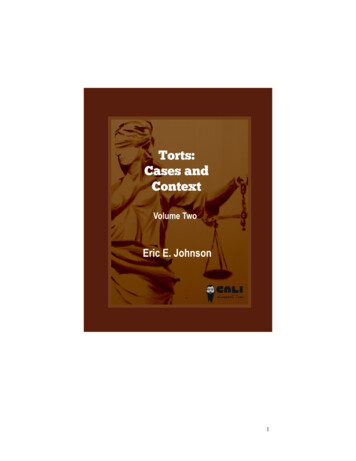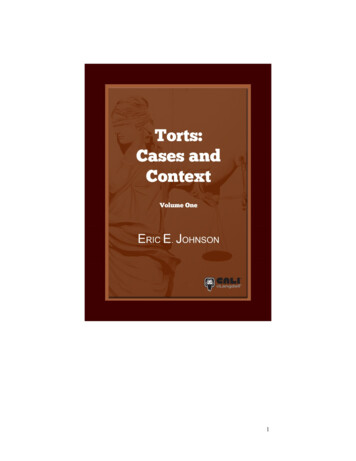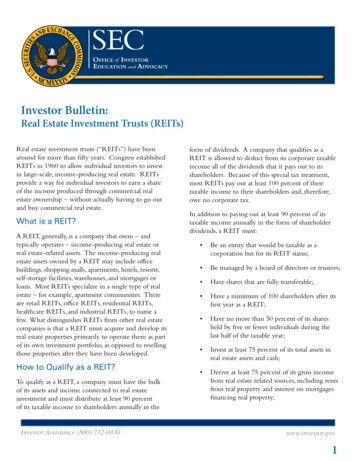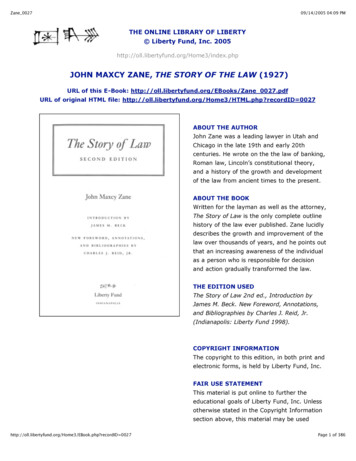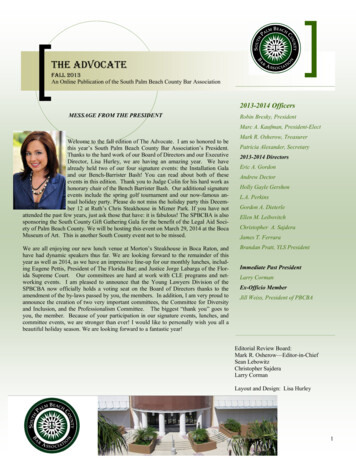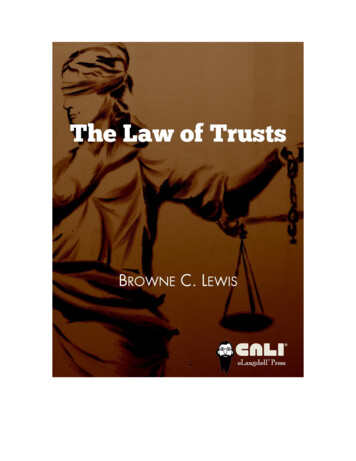
Transcription
The Law of TrustsBrowne C. LewisAssociate ProfessorLeon and Gloria Plevin Professor of Law & Director, Center for Health Law & PolicyCleveland-Marshall College of Law, Cleveland State UniversityeLangdell Press 2013ii
About the AuthorProfessor Lewis graduated number one in her class with a degree in Political Science fromGrambling State University. Prior to attending law school, Professor Lewis received summerfellowships to study at Carnegie-Mellon University, the Hubert H. Humphrey Institute at theUniversity of Minnesota and the John F. Kennedy School of Government at HarvardUniversity.Professor Lewis started her professional career as a statistician and ADR trainer at theConflict and Change Center in Minneapolis, Minnesota. Then, she clerked for theHonorable Daniel Wozniak, Chief Judge of the Minnesota Court of Appeals. ProfessorLewis practiced in the areas of environmental, elder, family, housing and probate law.Professor Lewis spent most of her career working as a legal services attorney.Professor Lewis is the Leon & Gloria Plevin Professor of Law and the Director of theCenter of Health Law & Policy at Cleveland-Marshall College of Law. Prior to joining thefaculty at Cleveland-Marshall, Professor Lewis was an associate professor at the Universityof Detroit Mercy School of Law, a visiting professor at the University of Pittsburgh Schoolof Law, a summer visiting professor at Seattle University School of Law and a legal writinginstructor at Hamline University School of Law. Professor Lewis has also taught in theAmerican Bar Association CLEO Summer Institute.Lewis is a member of the American Society of Law, Medicine & Ethics, the Health CareCompliance Association, the Public Health Law Association and the American HealthLawyers' Association. Professor Lewis is also a public member of the Board of the JointCommission and a member of Cleveland State University's Institutional Review Board(IRB).Professor Lewis writes in the areas of environmental, family and reproductive law. Her nextmost recent article on surrogacy and maternity is forthcoming in the St. John’s Law Review.Professor Lewis has recently completed a book on paternity and artificial insemination forNew York University Press. In 2010, Professor Lewis' casebook on the inheritance rights ofchildren was published by Carolina Academic Press.iii
NoticesThis is the first version of this casebook. Visit http://elangdell.cali.org/ for the latest versionand for revision history.This work by Browne C. Lewis is licensed and published by CALI eLangdell Press under aCreative Commons Attribution-NonCommercial-ShareAlike 3.0 Unported License. CALIand CALI eLangdell Press reserve under copyright all rights not expressly granted by thisCreative Commons license. CALI and CALI eLangdell Press do not assert copyright in USGovernment works or other public domain material included herein. Permissions beyondthe scope of this license may be available through feedback@cali.org.In brief, the terms of that license are that you may copy, distribute, and display this work, ormake derivative works, so long as you give CALI eLangdell Press and the author credit; you do not use this work for commercial purposes; and you distribute any works derived from this one under the same licensing terms asthis.Suggested attribution format for original work:Browne C. Lewis, The Law of Trusts, Published by CALI eLangdell Press (2013). Availableunder a Creative Commons BY-NC-SA 3.0 License.CALI and eLangdell are United States federally registered trademarks owned by theCenter for Computer-Assisted Legal Instruction. The cover art design is a copyrighted workof CALI, all rights reserved. The CALI graphical logo is a trademark and may not be usedwithout permission.Should you create derivative works based on the text of this book or other CreativeCommons materials therein, you may not use this book’s cover art and the aforementionedlogos, or any derivative thereof, to imply endorsement or otherwise without writtenpermission from CALI.This material does not contain nor is intended to be legal advice. Users seeking legal adviceshould consult with a licensed attorney in their jurisdiction. The editors have endeavored toprovide complete and accurate information in this book. However, CALI does not warrantthat the information provided is complete and accurate. CALI disclaims all liability to anyperson for any loss caused by errors or omissions in this collection of information.iv
About CALI eLangdell PressThe Center for Computer-Assisted Legal Instruction (CALI ) is: a nonprofit organizationwith over 200 member US law schools, an innovative force pushing legal education towardchange for the better. There are benefits to CALI membership for your school, firm, ororganization. ELangdell is our electronic press with a mission to publish more open booksfor legal education.How do we define "open?" Compatibility with devices like smartphones, tablets, and e-readers; as well as print. The right for educators to remix the materials through more lenient copyrightpolicies. The ability for educators and students to adopt the materials for free.Find available and upcoming eLangdell titles at elangdell.cali.org. Show support for CALI byfollowing us on Facebook facebook.com/caliorg and Twitter @caliorg , and by tellingyour friends and colleagues where you received your free book.v
Table of ContentsAbout the Author . iiiNotices . ivAbout CALI eLangdell Press . vPreface . viiiChapter 1 - The Capacity to Create a Testamentary Trust. 11.1. Parties Involved in a Trust Arrangement . 21.2. Testamentary Capacity. 4Chapter 2 - Creation of a Private Trust . 461.2 Intent to Create a Trust . 462.2 Requirement of Trust Property . 53Edwards v. Edwards . 542.3 Necessity of Trust Beneficiaries . 63Chapter 3 - Categories of Private Trusts. 713.1. Private Expressed Trusts. 713.2. Trusts Created By Operation of Law . 93Chapter 4 - Discretionary and Support and the Rights of the Beneficiary’sCreditors .1224.1 Discretionary Trusts. 1254.2. Support Trust . 131Chapter 5 - Spendthrift Trusts and Creditors .1405.1 Expressed Spendthrift Trust. 1415.2 Implied Spendthrift Trust . 1425.3 Creditors . 149Chapter 6 - Modification and Termination of Trusts .1746.1 Termination . 1756.2 Claflin and Material Purpose . 1826.3 Deviation and Changed Circumstances . 1866.4 Removal of the Trustee . 194Chapter 7 - Creation and Modification of Charitable Trusts .2017.1 Creation of the Charitable Trust . 2017.2 Modification/Cy Pres . 207Chapter 8 - Supervision/Enforcement of Charitable Trusts . 2378.1 Donor Standing . 2378.2 Beneficiary Standing. 248Chapter 9 - Treatment of Trust Property . 2549.1 The Duty to Collect and Protect Trust Property. 2549.2 The Duty to Earmark Trust Property and to Not Comingle Trust Funds . 2549.3 The Duty Not to Delegate . 2609.4 Duty of Prudence . 261Chapter 10 - Duty of Loyalty . 282Chapter 11 - Duty of Impartiality . 302Chapter 12 - Duty to Account and Inform . 32312.1 To Account . 32412.2 To Inform. 346vi
12.3The Trustee’s Liability . 358vii
PrefaceRecently, the public waited patiently to find out the contents of Whitney ElizabethHouston’s will. People were entertained by her music and fascinated by her death. Thus, it isno surprise that they were on the edge of their seats to discover how much money she had inher estate. Inside Edition and other entertainment shows teased the public with previewsstating that they had received a copy of the will and planned to reveal its contents. The bigreveal fell short when the public realized that Houston had left everything to her daughterusing a testamentary trust. Wills are public documents, but trust instruments are not.Therefore, the public will never know the specific provisions contained in the trustdocument. Privacy is one of the reasons why more and more people are disposing of theirproperty using testamentary trust created in their wills. The reasons people establish trustsare as varied as the lawyers who draft them. Traditionally, trusts were vehicles wealthypeople used to provide for their love ones. Currently, people from all economic classesestablish trusts. Thus, for students desiring to practice in the probate or elder law arena, it iscrucial that they have a basic understanding of the law of trusts.The standard four-credit Wills & Trusts courses taught at most law schools do notspend a sufficient amount of time on the law of trusts. Professors teaching such courseshave the daunting task of teaching intestacy, wills, non-probate transfers, estates, and trusts.The semester is not long enough to give detail coverage to all of the important topics.Consequently, professors have to decide what material to omit. Typically, the material on thelaw of trusts is either omitted or severely shortened. One obvious reason for the treatmentof the trust information is the fact that the chapters on trusts are in the latter part of mostcasebooks. It is difficult to predict the pace at which the material will be covered. Thus,most professors have to adjust their reading assignments. Those adjustments usually requirethe professors to cut assigned materials. Frequently, by the time the decision to reduce thereading assignments needs to be made, the only significant material left to be covered are thechapters on the law of trusts. Hence, that material is routinely omitted.The use of testamentary trusts is becoming an important part of estate planning. As aresult, students who want to make a living as probate attorneys will need to know how trustsfit into estate planning. In addition, bar examiners realize that it is important for students tohave a basic knowledge of trust law. That realization will result in bar examination questionsviii
that test that knowledge. The Law of Trusts is designed for use as a supplementary text for acourse on wills and trusts and the primary text in a seminar or course exploring the law oftrusts.Since the settlor is dead when the testamentary trust becomes effective, thetestamentary trust is an irrevocable trust. The main focus of this book is on that type oftrust. However, the revocable inter vivos trusts will be briefly mentioned as it relates to thetestamentary trusts. Most of the legal issues surrounding the law of trusts come fromchallenges to the creation and implementation of the trusts. In addition, even if thetestamentary trust is deemed to be valid, the actions of the trustee may lead to litigation. Thisbook is divided into two components to address the issues that arise in those two types oflitigation.Part I explores the legal issues involved in the creation, modification andimplementation of private and charitable trusts. In order to have a trust invalidated, theopponent must successfully challenge the capacity of the settlor or the procedure used tocreate the trust. Part I contains a chapter that examines the level of mental ability a personmust have to create a trust. Other chapters in this part explains the steps that must be takento create, modify and terminate a trust and compares the various types of private trusts.Part II discusses the administration of private and charitable trusts. In particular, thepart focuses upon the numerous duties of the trustee. Trusts are usually created to protect aperson who is vulnerable in some way. In a lot of respects, that person is at the mercy of thetrustee. Any decision that the trustee makes, good or bad, directly impacts the beneficiary.In order to protect the beneficiary from the actions of the trustee, the law imposes afiduciary duty on the trustee. Chapters in Part II analyze the trustee’s duties and the remediesavailable to the beneficiary in the event of the trustee’s breach of any of those duties. Part IIalso includes a discussion of powers of appointments and their relevancy to trusts. Thisdiscussion is necessary because bar examinations frequently contain questions dealing withpowers of appointment.In additional to cases, the book contains problems, notes and questions. The casesare designed to give the student a clear understanding of the law. The problems are includedto permit the student the opportunity to apply the law. The notes and questions are providedso the student will think critically about the policies behind the law and the outcome of thecases.ix
Chapter 1 - The Capacity to Create aTestamentary TrustThis chapter is divided into two parts. Part I introduces students to the parties thatare involved in the creation of a trust. Further, that part discusses the function of each of theparties. Most trusts are testamentary in nature, so they are created as a part of a will. In orderfor a testamentary trust to be valid, the testator must be legally capable of executing the trust.Thus, in Part II of the chapter, I discuss the mental capacity the testator must possess to bedeemed competent to create a trust. In addition, the students will be introduced to the otherlegal theories that may be used to attack the testator’s ability to establish a trust.The primary purpose of a trust is to provide a source of income for a person who isnot capable of managing his or her resources. For instance, Barbara’s son, John has agambling problem. Barbara wants to make sure that John always has a place to live. IfBarbara gives John a house outright, he would probably lose it in a card game. Barbaracannot give John the house and forbid him from transferring it because a direct restraint onalienation is invalid. Thus, the court would ignore the condition and give John the housewithout the restriction. Barbara can give John a life estate in the property, so that he wouldhave a place to live until he died. Granting John a life estate may not be a good idea forseveral reasons. A legal life tenant has a duty to pay taxes and to maintain the property ingood repair. However, that duty is limited because the life tenant only has to fulfill thatobligation to the extent the income from the property is sufficient to cover those expenses.It is unlikely that the house will produce any income, so John would not be obligated to paythe property taxes or to keep the house in good repair. Even if John has such a duty, he isprobably too irresponsible to do so. Thus, giving John a life estate in the house may causemore problems than it cures. Moreover, if the life tenant accrues debt, that person’s creditorcan legally seize the life estate and sell it. The creditor would probably realize very little fromthe sale. But, the sell of the life estate will defeat Barbara’s purpose of providing John with aplace to live. Barbara’s best option is to put the house in trust for John. This means thatBarbara would give the legal title of the house to a third party. That person would beresponsible for maintaining the house for John. As the beneficiary of the trust, John wouldhave equitable title of the house. Since John would not have legal title, he would be unable to1
sell or gamble away title to the house. Thus, the creation of a trust would enable Barbara toachieve her objectives.1.1.Parties Involved in a Trust ArrangementUsually, at least three parties are involved in the creation of a trust. Those parties arethe settlor/trustor, the trustee, and one or more beneficiaries. In cases involvingtestamentary trusts, the settlor is referred to as the testator. Three different individuals donot have to be involved in the transaction in order for a valid trust to be established. Forexample, one person can serve as the settlor and the trustee. If a self-settled trust is involved,it is possible for one person to serve in all three capacities. However, for the trust to bevalid, the trustee must owe equitable duties to someone other than herself. Thus, if thesettlor is also the trustee, she cannot be the only trust beneficiary. The settlor/trustor is theperson who creates the trust. Since she is the person who established the trust, Barbara is thesettlor or trustor.The third party who manages the trust is the trustee. The trustee may be anindividual or a corporation. The settlor may select one trustee or several trustees to managethe trust. The trustee may be appointed by the trust instrument or by the court. The personor entity appointed as trustee must affirmatively accept the role. Once the trustee accepts theappointment as trustee, the person can be released of the obligation only with the consent ofthe beneficiaries or by a court order. The trustee is entitled to receive reasonablecompensation. A trust will not fail for lack of a trustee. If the trustee dies and no successortrustee is named in the trust instrument, the court will appoint a successor in trustee.However, if the trust instrument or other facts indicate that the settlor chose the person toact as trustee because of the nature of their relationship, the court may conclude that thesettlor would not want the trust to continue without that trustee. As a result, the court maydissolve the trust on the death or resignation of the trustee. If the trust is created as a part ofa will, the executor can also serve as the trustee.The trust instrument must give the trustee some active duties to perform. A settlorwho gives the trustee no managerial responsibilities creates a dry trust. As a result, the courtwill not recognize the creation of the trust, and the beneficiary will receive legal title to thetrust property. The following example illustrates a dry trust:2
Example-Utilizing an instrument entitled “Trust For the Benefit of Robertoand Marianna” Sophia placed one million dollars in an irrevocable trust forher two children, Roberto and Marianna. She selected Vincent to serve astrustee. Under the terms of the trust, 100,000 would be automatically pacedin the respective bank accounts of Roberto and Marianna each month.Sophia never informed Vincent that he was to serve as trustee.The above-referenced transaction did not result in a valid trust because the funds wereautomatically dispensed to Roberto and Marianna. Vincent had no managerial duties. Thefact that the trust could function without Vincent’s knowledge further indicates that it was apassive or dry trust. Consequently, the court would invalidate the trust and Roberto andMarianna would have the right to split the million dollars and obtain it without restrictions.The trustee has legal title to the trust property, and the beneficiary has equitable title.Consequently, the trustee has the managerial authority over the property. Nevertheless, thebeneficiary is the one who suffers the consequences of the trustee’s good or bad decisions.In the example put forth at the beginning of the chapter, the trustee has legal title to thehouse and manages it for the benefit of John. Although the trustee has legal title to thehouse, a personal creditor of the trustee has no recourse against the house. If the trusteeacquires an obligation on behalf of the trust, the creditor has recourse against the house, butnot against the trustee’s personal property.Example 1-Keisha devises Purpleacre in trust to Robert to pay income toGary for life and the remainder to LaNitra on Gary’s death. Robertaccidentally hits April with his car. April files suit against Robert and receivesa judgment for 300,000. Although Robert has legal title to Purpleacre, Aprilcannot place a lien on Purpleacre to satisfy her judgment.Example2-Gloria devises Blackacre in trust to Tamera to pay income to Alifor life and the remainder to Patrick on Ali’s death. Tamera contracts withJason to make repairs to Blackacre. Jason submits a bill to Tamera for 40,000. Tamera refuses to pay the bill. Jason can go to court and get amechanic’s lien on Blackacre. However, Jason cannot sue Tamera personallyfor the debt.The beneficiary of the trust is the person who receives the benefit of the trustee.John is the beneficiary of the trust because it was created so he would have a place to live.3
John has the equitable title to the house. John’s equitable interest entitles him to sue thetrustee personally for breach of trust. Moreover, equity gives John, as beneficiary, the rightto live in the house. Thus, if the trustee wrongfully disposes of the house, John can recoverthe house unless it has come into the hands of a bona fide purchaser for value. In addition, ifthe trustee disposes of the house and acquires other property with the proceeds of the sale,John can enforce the trust on the newly obtained property.Example-Ivana devises Brownacre in trust to Jessica for George for life andthe remainder to Katherine on George’s death. Jessica sells Brownacre toRobin, a BFP, and buys Blueacre. George can sue to receive equitable title toBlueacre.In the above example, since Robin, a BFP, acquired legal title to Brownacre, George isunable to maintain his equitable interest in the property. George’s remedy is to sue to getthe proceeds Jessica received from the sell of Brownacre or to obtain an equitable interest inBlueacre.1.2.Testamentary Capacity1.2.1. Mental CapacityIn order to create a testamentary trust the testator must be an adult and must be ofsound mind. A person who is 18 years of age or older is considered to be an adult. It isdifficult to determine if the person was “of sound mind.” The level of mental ability thetestator needs is really low. For instance, a person suffering from dementia or Alzheimer’sdisease may be competent to establish a testamentary trust as long as the person has lucidmoments. In order to have the necessary mental capacity to create a valid testamentary trust,the testator must know the following: (1) the nature and extent of his property; (2) thepersons who are the natural objects of his bounty: (3) the disposition he is making; and (4)the manner in which those facts relate so far as to form an orderly plan for the disposition ofhis property.To be found to be mentally competent, the testator does not have to have actualknowledge of every piece of property that will be included in the trust. The testator also doesnot have to be able to name every relative that may be a beneficiary of the trust.In the Matter of the Estate of Gallavan, 89 P. 3d 521Opinion by Judge CARPARELLI4
In this formal testacy proceeding as to the estate of Donna L. Gallavan (decedent),Joseph James Verce, Jr. (contestant), as personal representative of decedent’s sister, Carla M.Verce, appeals the trial court’s judgment denying his petition for adjudication of intestacy.Phillips R. McClendon, as decedent’s personal representative, and Shriners Hospitals forChildren, as a devisee, opposed the petition. We affirm.Decedent was a protected person under conservatorship when she executed a willthat contained a testamentary trust for the benefit of her sister and brother during their lives.Upon the death of both beneficiaries, the trust was to terminate, and trust proceeds were tobe distributed to Shriner’s Hospitals.Decedent died in July 1999. Her personal representative submitted the will toinformal probate. Decedent’s sister survived decedent, but died in September 1999. Herbrother also survived her but died in October 2011 while the estate was in probate.Contestant later filed the petition for adjudication of intestacy at issue here, alleging thatdecedent lacked testamentary capacity to execute the will.Contestant urges us to conclude that the will is invalid because decedent lackedtestamentary capacity. We perceive no basis for such a conclusion.A person has testamentary capacity if he or she is an “individual eighteen or moreyears of age who is of sound mind.” Section 15-11-501, C.R.S. 2003. The soundness of atestator’s mind may be evaluated under either the Cunningham test or the insane delusion test.See Breeden v. Stone, 992 P.2d 1167 (Colo. 2000); Cunningham v. Stender, 127 Colo. 293, 255 P.2d 977 (1953).Under the Cunningham test, a person has testamentary capacity when (1) sheunderstands the nature of her act; (2) she knows the extent of her property; (3) sheunderstands the proposed testamentary disposition; (4) she knows the natural objects of herbounty; and (5) the will represents her wishes. Cunningham v. Stender, supra.A.Contestant contends that the judicial appointment of the conservator establishes thatdecedent was “incapacitated” and, thus, that she lacked testamentary capacity. We are notpersuaded.Contestant first points to the language of § 15-14-401(1)(b), C.R.S. 2003, whichallows appointment of a conservator for one who is unable to manage property and businessaffairs because of inability “to effectively receive or evaluate information or both or to make5
or communicate decisions” affecting her assets. He then points to the statutes that allowappointment of a guardian for an “incapacitated persons,” defined in § 15-14-102(5), C.R.S.2003, as, in pertinent part, one who is unable “to satisfy essential requirements for physicalhealth, safety, or self-care,” because of inability “to effectively receive or evaluateinformation or both or make or communicate decisions.” He argues that the provisionsinclude similar phrases and that, as a result, the appointment of decedent’s conservatorestablishes that decedent was “incapacitated” when she wrote the will. This argument iscontrary to the explicit language of the statutes.When the meaning of a statute is plain and free from ambiguity, we may concludethe legislature made a deliberate choice that was “calculated to obtain the result dictated bythe plain meaning of the words,” Hendricks v. People, 10 P.3d 1231, 1238 (Colo. 2000)(quoting City & County of Denver v. Gallegos, 916 P.2d 509, 512 (Colo. 1996), and we giveeffect to that meaning without resorting to rules of statutory interpretation. In re Estate ofDeWitt, 554 P.3d 849 (Colo. 2002).Section 15-14-401 pertains to the appointment of a conservator to ensure that assetsa person needs for her own support, care, education, health, and welfare, or for that ofothers who are entitled to her support, are not wasted or dissipated. The appointment of aconservator does not include a finding of “incapacity.” In fact, when decedent wrote herwill, the version of § 15-14-408 (6) then in effect provided that “[a]n order determiningthat a basis for appointment of a conservator exists, has no effect on the capacity of theprotected person.” Colo. Sess. Laws 1979, ch, 451, § 153-5-408(6)
Lewis practiced in the areas of environmental, elder, family, housing and probate law. Professor Lewis spent most of her career working as a legal services attorney. Professor Lewis is the Leon & Gloria Plevin Professor of Law and the Director of the Center of Health Law & Policy at Cleveland-Marsh
